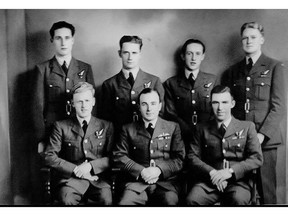Calgary WWII airman who 'flew to hell and back' reunited with lost medals

Article content
Henry “Hank” Jackson was once the tail-gunner in a Halifax Bomber.
Flying a staggering 34 successful missions with his flight crew, dubbed the “Murphy Crew,” Jackson was among seven airmen awarded the Distinguished Flying Cross.
“For a crew to get seven Distinguished Flying Crosses … I’ve never heard of that before,” said Karl Kjarsgaard, RCAF historian and director of the Bomber Command Museum in Nanton.
But some years ago, Jackson’s medals went missing after his daughter offered to put them in a display box. His daughter fell ill and died shortly after, and the medals disappeared when her estate was cleared.
When Kjarsgaard discovered Jackson’s medals were missing, he made it his mission to track down the lost medals as a way to honour the Murphy Crew and all the airmen of the RCAF killed in the Second World War.
“We spent weeks over 2015-2016, phoning everybody in the entire family and we finally found them in a safety deposit box in Manitoba,” Kjarsgaard said. “But it wasn’t just the medals, it was the letter from the commanding officer of Bomber Command congratulating him for the (Distinguished Flying Cross) … it was the icing on the cake.”
Now 95-years-old, Jackson credits his successful 34 missions to the teamwork and skill of the entire Murphy Crew.
“They were all good guys, we worked together good,” Jackson said. “It was a crew effort, just the seven of us … the navigator was really good, because he made sure before we left that he knew where all the fighter bases were so we could try and dodge around some of the bad ones.”
Take a trip to the Bomber Command Museum in Nanton and you will be greeted by the Lancaster bomber which, according to Kjarsgaard, receives most of the credit for helping win the war.
In reality, the RCAF flew only 403 Lancasters in the last six months of the war, while the smaller Halifax Bomber was the tip of the spear in the RCAF with a total of 1,230 bombers in service during the war.
Kjarsgaard said the lion’s share of the glory belongs to a lesser-known Halifax Bomber and the crews who flew them.
“The Halifax was the workhorse (of the RCAF) for three years,” Kjarsgaard said. “70 per cent of all bombing missions (flown by the RCAF) were in a Halifax – they flew to hell and back in a Halifax.”
Kjarsgaard is working to bring the legacy of the Halifax Bomber front and centre by leading the Halifax 57 Rescue project to salvage one of the few remaining bombers ever found. The bomber, called HR871, is currently sitting in 50 feet of water just a few miles offshore of the southern tip of Sweden.
When recovered, the parts will be reconstructed and sent to Nanton to honour the men who fought and died in Halifax Bombers.
“This is my third Halifax recovery, but its the one that will come to the Bomber Command Museum,” Kjarsgaard said.
The Halifax 57 Rescue project is accepting donations through crowdfunding.
“Karl’s determined,” Jackson said. “He’s gonna get a Halifax.”






Postmedia is committed to maintaining a lively but civil forum for discussion. Please keep comments relevant and respectful. Comments may take up to an hour to appear on the site. You will receive an email if there is a reply to your comment, an update to a thread you follow or if a user you follow comments. Visit our Community Guidelines for more information.